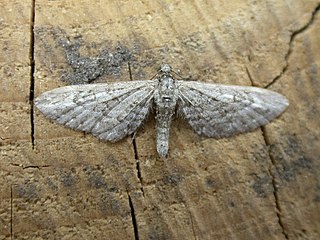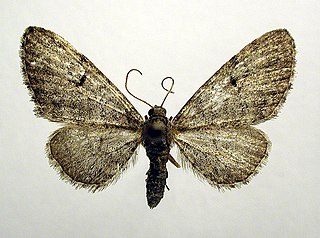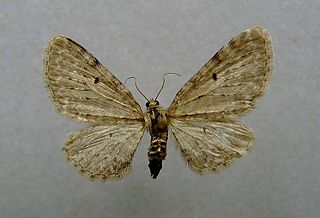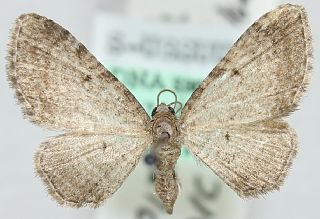
Eupithecia is the largest genus of moths of the family Geometridae, and the namesake and type genus of tribe Eupitheciini. Species in the genus are, like those of other genera in the tribe, commonly known as pugs. The genus is highly speciose, with over 1400 species, and members of the genus are present in most of the world with exception of Australasia. Roughly a quarter of described Eupithecia species occur in the Neotropical realm, where they have an especially high species diversity in the montane rain forests of the Andes. The genus includes a few agricultural pest species, such as the currant pug moth, Eupithecia assimilata, which is a pest on hops, and the cloaked pug moth, Eupithecia abietaria, which is a cone pest in spruce seed orchards.

Eupithecia nanata, the narrow-winged pug, is a moth of the family Geometridae. The species was first described by Jacob Hübner in 1813. It can be found all over Europe including Russia and Ukraine. In the Alps it occurs up to 2,200 metres (7,200 ft) above sea level and in the Pyrenees to 2400 meters. The species prefers dry or boggy heathlands.

Eupithecia egenaria, the pauper pug, is a moth of the family Geometridae. It is known from almost all of Europe, except Portugal, Ireland and the southern part of the Balkan Peninsula.

Eupithecia veratraria is a moth of the family Geometridae first described by Gottlieb August Wilhelm Herrich-Schäffer in 1848. It is found from the mountainous areas of Europe and Asia up to Japan.

Eupithecia distinctaria, the thyme pug, is a moth of the family Geometridae. It is found throughout Europe. It is also found in Iran. from the Iberian Peninsula through western and central Europe including the British Isles as well as further east as far east as far as Russia and Iran. In the north the range reaches as far as the southern Fennoscandia, to the south, where it is more common, it occupies the Mediterranean and Asia Minor. It is found primarily on warm, stony slopes and rocky structures as well as on sparse grassy areas with thyme mounds. In the Alps, it rises to heights of 2000 metres.

Eupithecia addictata is a moth in the family Geometridae. It is found from north-eastern Italy, through Austria, northern Hungary and southern Slovakia to Ukraine, Russia and Japan. It is also found in the southern Balkan Peninsula.
Eupithecia alliaria is a moth in the family Geometridae. It is found from France and the Iberian Peninsula east through south-central Europe to Russia and most of the Balkan Peninsula. It is also found in the Near East and North Africa.

Eupithecia silenicolata is a moth in the family Geometridae. It is found from southern Europe and Morocco to western Asia, Iran and Pakistan. In the north, the range extends to southern Switzerland, Austria and northern Italy.
Eupithecia carpophagata is a moth in the family Geometridae. It is found in the mountains of Europe, including the eastern Pyrenees, the central and southern part of the Alps, the Massif Central, the central Apennines and the Balkan Peninsula.

Eupithecia cocciferata is a moth in the family Geometridae. It is found on the Iberian Peninsula, in France, Italy, Croatia, North Macedonia and on Corsica and Sardinia, as well as in North Africa.

Eupithecia cretaceata is a moth in the family Geometridae. It is widely distributed in Canada and much of the United States. In Europe, it is found in France, Switzerland, Austria and parts of the Balkan Peninsula.
Eupithecia undata is a moth in the family Geometridae first described by Christian Friedrich Freyer in 1840. The North American Moth Photographers Group lists it as a synonym of Eupithecia lafontaineata. It is found in the Pyrenees, Alps, the Massif Central, the Tatra mountains, on the Balkan Peninsula and in Romania. It is also found in North America, where it has been recorded from Wyoming, Montana, Idaho, Colorado, Nevada and Oregon.

Eupithecia druentiata is a moth in the family Geometridae. It is found in France, Spain, Italy, Austria, Slovenia and most of the Balkan Peninsula.
Eupithecia gratiosata is a moth in the family Geometridae. It is found in France, the Iberian Peninsula, Italy, the Balkan Peninsula, Ukraine, Poland, Russia, Turkmenistan, Kazakhstan, the Near East and Iran.
Eupithecia liguriata is a moth in the family Geometridae. It is found in Italy, France and on the Iberian Peninsula, as well as in North Africa.
Eupithecia pauxillaria, the parsimonious pug, is a moth in the family Geometridae. It is found in most of Europe, except Ireland, Great Britain, Portugal and northern Europe and the central part of the Balkan Peninsula.
Eupithecia sardoa is a moth in the family Geometridae. It is found in North Africa and on Corsica, Sardinia, and Mallorca. It was recently recorded from the Parco Naturale della Maremma in Italy.
Eupithecia schiefereri is a moth in the family Geometridae. It is found from North Africa through central Spain, southern France, the central and southern Alps, Italy and the southern Balkan Peninsula to eastern Turkey and northern Iran.
Eupithecia tenellata is a moth in the family Geometridae. It is found in North Africa, Iran and the Arabian Peninsula.
Eupithecia kurilensis is a moth in the family Geometridae. It is found on the Kamchatka Peninsula and the Kuriles and in Japan.








